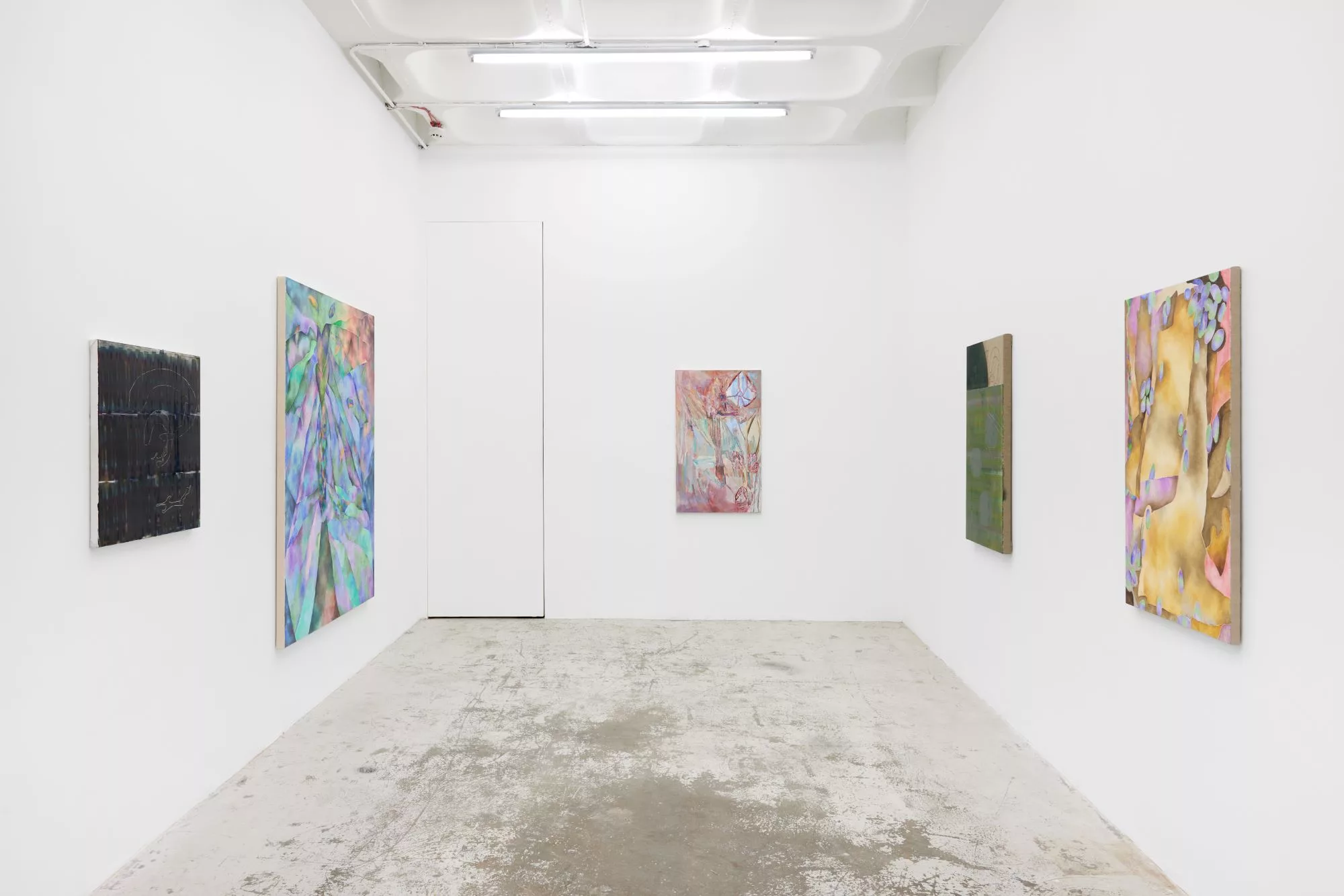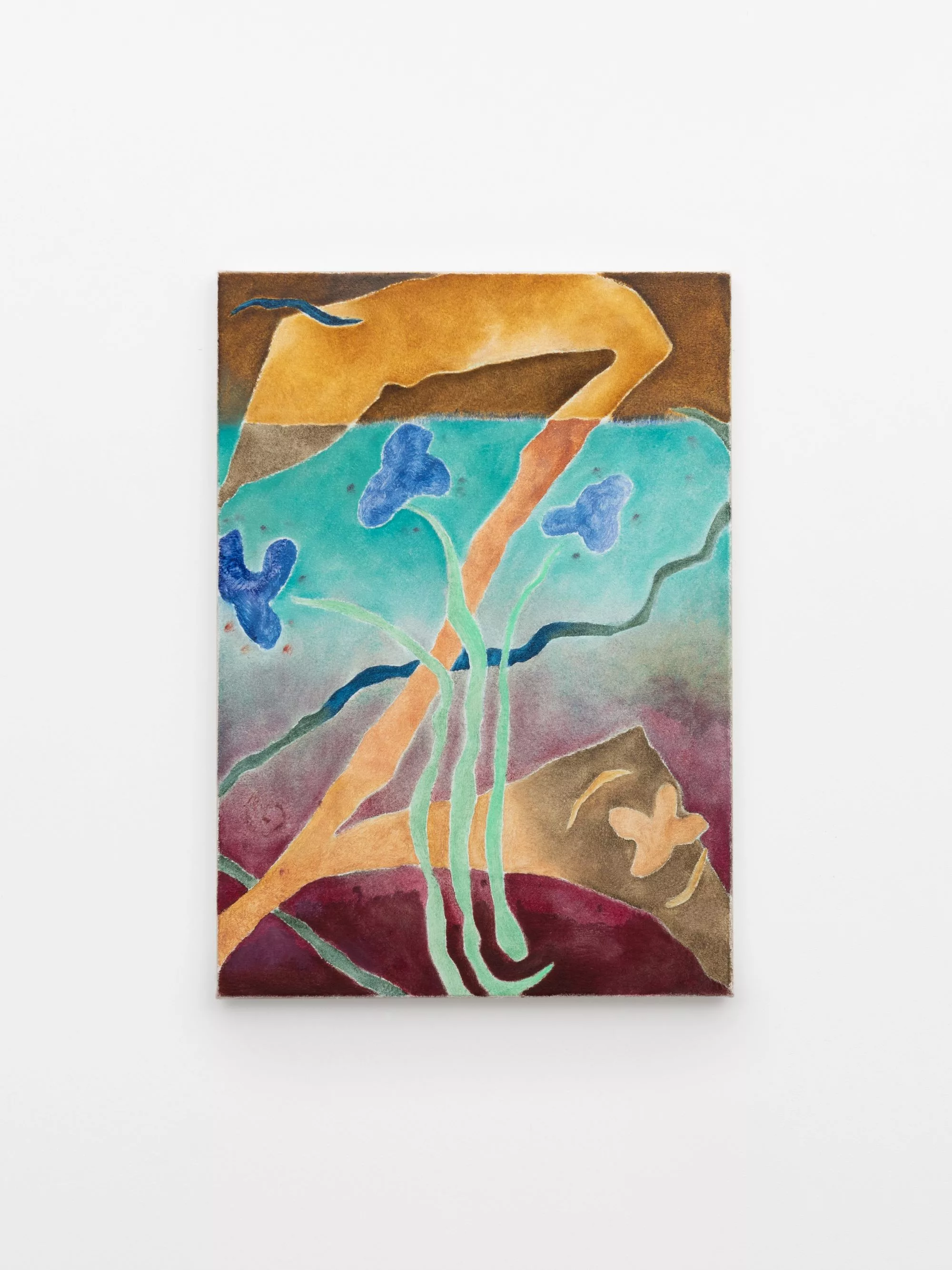
Vibrant oil paint refracts across the canvas, transitioning fluidly from deep amethyst purples to radiant yellows before merging into verdant greens. The surface of the canvas is segmented into patches of colour, sometimes dispersed and contained, at other times dense and concentrated. “I realised that I was not being true to myself in my work. Then, I learnt to follow my instinct.” In her paintings, Kiki Xuebing Wang draws inspiration from specific memories or objects, oscillating a delicate balance between abstraction and representation. Layers of colour and texture blend and intersect in repetitive patterns. Yet, upon closer inspection, subtle hints of representation emerge, hinting at familiar shapes and forms that evoke a sense of nostalgia. Her work exists in the liminal space between the tangible and the intangible, where fractured surface planes and divisions of personal memories converge to form a cohesive whole. Through her paintings, Wang explores the complexities of perception, acknowledging that it often veers far from capturing the whole truth. Her work invites viewers to contemplate the intricacies of human experience, challenging them to confront the fragmented nature of reality and the subjective nature of perception.
“I think memories are always fractured; you recollect small pieces to form a story, view, or image. It is a space which can be walked through.” Layering, cutting, and wiping the painted surface, her process tends to follow her curiosity and intuition alongside exploring historical and painterly approaches aimed at transcending rational interpretations of imagery. “Monet’s Water Lilies are, to me, less about the water lilies and more about how he painted the pond…” Wang says, reflecting on her art’s historical influences. “I visited Giverny, where Monet lived for four decades, one summer. The pond there reflects light cast by the trees; it’s like an endless universe, especially when there’s a breeze.” Reflections dance in distorted forms, just as when I see the painting of Fra Angelico’s Madonna of the Shadows on marble: a flat surface, yet it has a depth that’s full of possibilities.” Fra Angelico’s Madonna of the Shadows fresco was the starting point for a recent group show, Sympathetic Magic 2 at Ginny on Frederick in London, which brought together three artists: Ed Compson, Francesca Mollett and Kiki Xuebing Wang in a collaborative presentation. The fresco has predominantly received attention for its upper half, depicting its biblical narrative; the lower section of the fresco, characterised as marble imitations with “blotches” of vibrant colours and decorative motifs, has been largely disregarded by scholars. This neglected portion, divided into four sections and adorned with trompe l’œil borders, brought the artists together.
“Francesca Mollett and I went to see the fresco paintings in San Marco in Florence last summer, and we were both blown away…” says Wang.
In the studio, the artist meticulously applies thin layers of paint to the canvas, employing a palette of complementary colours. In Sand and Foam (2023), lilac and yellow hues blend, creating delicate petal-like shapes that cascade down through layered, paper-thin forms.
In The Glass (2023) features turquoise and burnt red tones, with a buttery-like form spreading across the canvas as the focal point. Drawing inspiration from her experiences living in Los Angeles and London, Wang’s vibrant paintings are a testament to the nuanced interplay of light and shadow.

How did your background in both the United States and China influence your artistic perspective and practice?
Growing up in China and living in the States has definitely provided me with a diverse set of relationships and experiences that have shaped my interests and curiosities. It’s difficult to pinpoint how this has influenced me exactly, as it’s the only life I’ve known, but it has undoubtedly impacted my practice in some way.
Can you share a specific experience or moment that inspired your fascination with visual patterns and their cultural significance?
For a long time, I used to try to avoid revealing my cultural background in my work and thought that as long as I could make good paintings, they would resonate with some audiences, but I came to feel this was a bit selfish. I started collecting images and visual patterns–either traditional Chinese patterns I grew up seeing or Western images that would speak to me–really trying to figure out what I am interested in, thinking, and curious about through the process of making.
Your work often explores the relationship between emotions and objects. How do you navigate this interplay in your work?
The interplay is fun and also challenging – one is intangible, and the other is tangible. In my work, I am becoming more and more focused on the emotions a painting can portray. Especially when there is 10% left to finish the painting, it always seems to go slower than the rest of the 90%. One of the reasons is that there is a fine line between seeing a painting as a painted surface and seeing a painting as the subject matter and then forming a judgement. Towards the end of a painting, I tend to let emotions come in more, and I try to remove the image that already exists in my mind. The challenge is that it’s against our visual logic – it’s hard to see a painting without ignoring the subject matter or object intentionally, so seeing the painting from an emotional point of view helps me navigate what I really want to say through the painted surface.

Could you elaborate on your choice of colour in capturing reflected light and the simulacrum world? What significance does this technique hold in your work?
My choice of colour varies on different paintings. They are reactions to certain feelings in different time periods, and their variation is because of memories from different locations. Different places have different lights. For example, it’s always sunny in Los Angeles, so you’d wear sunglasses most days. Therefore, you get to see richer colours clearly. In London, the sun is always hidden behind clouds; colours react to your eyes with a gloomy grey filter, so they are solid but less vibrant. But when it is sunny in London, you get a great contrast from your perception of the city or atmosphere, and the vibrant colours seem to be exaggerated because you compare it to your existing perception when it’s gloomy. I try to depict different light from different places through my choice of colours.
Layering and wiping are two different ways of adding. When you want to create depth, layering helps to form an illusion of the depth of an image. It can also determine the direction of light and the light source. The act of wiping is also adding despite itself being a way of removing. Wiping the painted surface is neither removing nor going back. The act of layering and wiping contributes to the idea of how memory is formed – the same goes for cutting. When you recollect some events in the past, it’s only a few words you remember, not a sentence; it’s the red jacket you wore, not your shoes; it’s always fragments of things, and you connect the fragments into a whole picture, that’s your own event, your own memory. The technique in my work draws a parallel to what I think memory is.

Your practice seems to challenge the traditional boundaries of painting, particularly in terms of two-dimensionality. How do you approach this exploration of spatial disruption and multi-layered surfaces?
I kind of see that as part of the charm and challenge of many types of paintings, bringing something to life. It’s not unique to my practice, but here are some things I think about: No matter how big the surface is, it always has edges, and the edges stop you from painting more unless you decide to paint the wall that the painting is on, but there are still edges of the wall. It’s similar to the surface being two-dimensional. The limitation makes it fun because it’s challenging. How do you tell a story or convey a feeling within a set size and proportion? How do you make it look bigger or as though it could go beyond the edges with a simple mark? How do you disrupt the space with different sizes and directions of brush marks?
How do you perceive the role of cultural rhetorics in the visual patterns you depict? How does this influence your artistic storytelling?
It’s a big question, and one that I hope becomes clearer when I look back on a lifetime of painting.
What emotions or memories do you aim to evoke or explore in your work?
I want that my work evokes different feelings and memories depending on the viewers’ own experiences, that they bring their own context to the work. Usually during the process of making, the work leads me to a place, and I enjoy the freedom of having the work take control.

Living and working in London, how do the environment and cultural landscape of the city influence your artistic practice?
Light affects my work living in London. London is a very connected city, where you can be out until 4 am in the morning, and there are still buses that can take you home. Both walking on the streets and taking public transportation allow you to interact with people; even though you don’t talk to strangers all the time, you can still have a conversation with your eyes, and in some way, it feels connected. Whereas in LA, I used to drive everywhere and spend most of my time in my car by myself, and nobody walked anywhere. The strange connection with people in London makes me more connected to myself. Hence, I stopped avoiding my instinct, my cultural background, or my feelings, which has directly impacted the outcome of my work.
Written by Sofia Hallström





